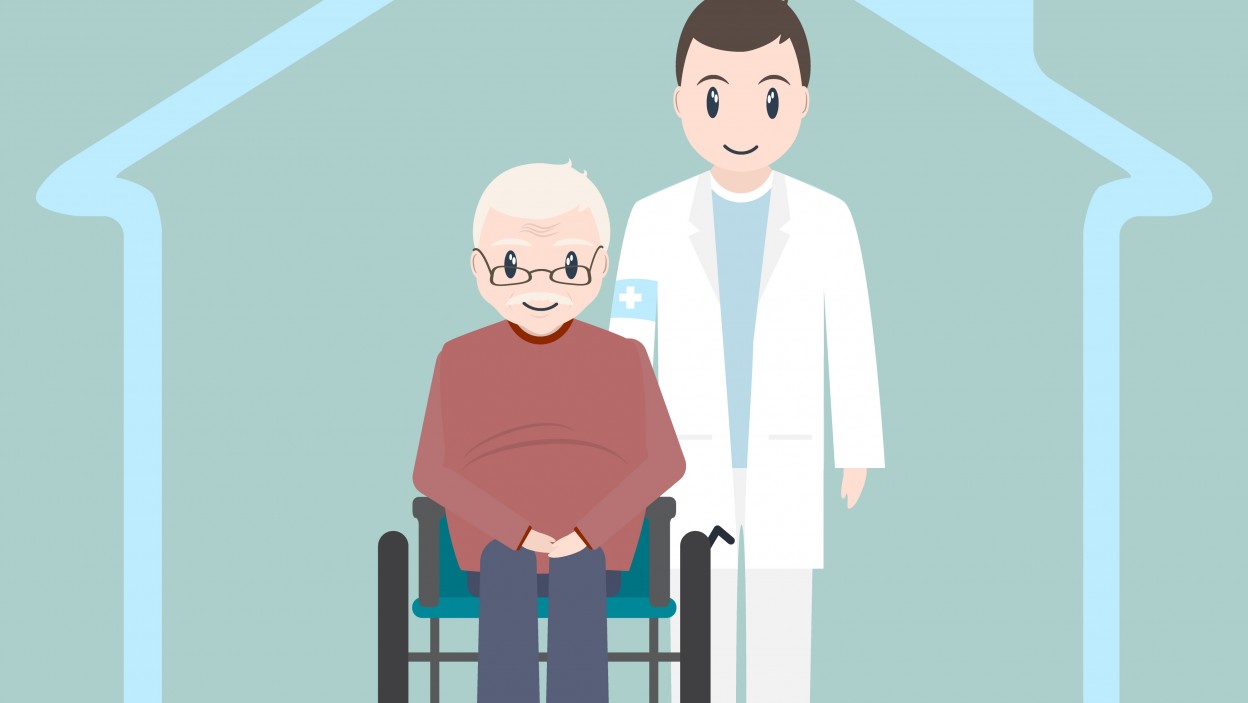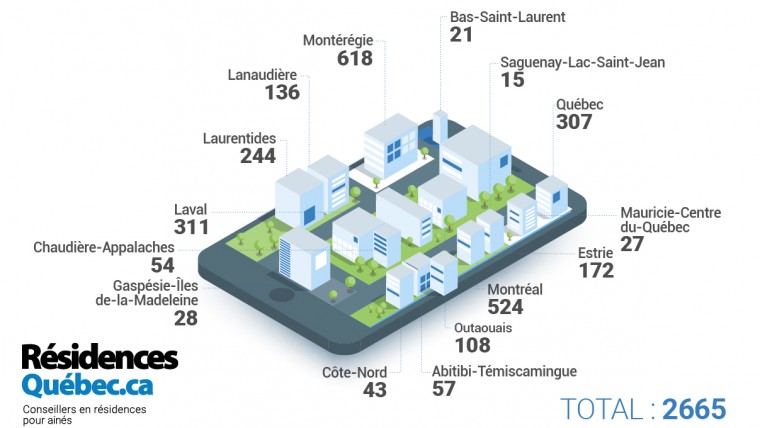This article outlines the steps involved in finding a senior’s residence in the public housing network in Québec and what do in case of a housing shortage.
Public residences prioritize those with a loss of autonomy
People with a loss of autonomy and that need care on a daily basis (supervision related to cognitive problems, assistance with mobility, with bathing and meals, dispensing and managing medication, physical therapy, motor and sensory stimulation, changing bandages and more) have priority in public residences. These facilities fall under the responsibility of the Ministère de la Santé et de Services sociaux. There are three types of residences under their jurisdiction:
- Intermediary resources (IR) or assisted living
For people with a moderate loss of autonomy (whose state of health is stable, but who require up to 3 hours of care per day). - Residential and long-term care centre (CHSLD)
For people with a significant loss of autonomy and more than one complex health problem (more than 3 hours of care per day). - Intermediate resources (IR) and privately funded CHSLDs (private but subsidized by the public sector)
These care facilities meet the same standards as the public sector and the criteria for getting a spot is the same. They are therefore affiliated with public sector IRs and CHSLDs. It’s only the ownership of the building that is different, as they’re owned by private contractors.
Criteria and pricing for public housing (or privately funded):
If someone wants to be admitted to a public facility or privately-funded centre, they must go through a fairly long and complicated process, depending on the human resources in place and how many spots there are available:
- The person must be evaluated by a social worker, a nurse or an occupational therapist from their local CLSC.
- If the person meets the criteria (number of hours of care and supervision required per day, availability of caregiver or not, etc.), in most cases, the person will be placed on a waiting list. Only urgent situations are exempt.
- Waiting times are approximately 18 to 24 months for the Montreal area.
- The cost of housing is determined by the Régie de l’assurance maladie du Québec (RAMQ) and is calculated based on income and, in the case of intermediate resources, the age of the person (under 65 and over 65).
- The RAMQ established its pricing criteria taking into consideration seniors living in their own homes. This means that people living in the public health network must also assume the expenses related to their lodging and food. However, healthcare remains free of charge for all Québec citizens, whether or not they are housed.
- To establish the cost for accommodation in a public residence, (also called “financial contribution for accommodated adults”), the government takes the following into account:
- The price of accommodation, depending on whether it’s a single room, a room with 2 beds or a room with at least 3 beds.
- The income of the person being accommodated (government pensions, private pensions, investments, etc.).
As of January 1, 2019, the maximum costs for accommodation in a public (or privately funded) CHSLD were as follows:
- Single room: $1,910.40
- Room with 2 beds: $1,596.00
- Room with 3 beds or more: $1,189.20
Accredited private residences: strict standards
Unfortunately, the healthcare system is in high demand, and supply cannot currently meet demand. This is why many seniors and their families opt for accredited private residences. There are many of these types of residences, which are privately owned and operated for profit. To become accredited, these facilities have to meet the very strict standards outlined by the Ministère de la Santé et de Services sociaux and comply with specific requirements regarding the following:
- Safety
- Serving food in accordance with the Canada Food Guide
- Access to the premises
- Access to care services
- Code of ethics for staff
- Leisure
- Etc.
Every two years, the certification boards renew the certificate of compliance for these facilities, provided they still meet the ministry’s standards.
Accredited private versus public residences
Unlike public or private residences, which only accommodate seniors with a loss of autonomy, accredited private residences offer a wide variety of living environments adapted to everyone’s needs. With 88,000 rental units available throughout the province, they offer accommodation (with or without leisure activities) for autonomous and semi-autonomous seniors, people with evolving needs and people who need assisted living. Many facilities offer meals served in a dining room. They can choose to eat 1 to 3 meals per day in the dining room or can prepare their own meals. The type of accommodation also varies according to budget and needs:
- Rooms
- Studios
- One- or two-bedroom apartments
- A room in a secure unit for people with cognitive impairments
- CHSLD-type accommodations with a long-term care permit
A beneficial tax credit
Accredited residences have a major advantage: they’re eligible for the tax credit for home-support services for seniors that’s offered to people aged 70 years and more. This tax credit covers expenses incurred so that seniors can perform the activities associated with daily living and help them remain independent at home for as long as possible. As such, monthly rent is reduced considerably and can cover the difference in cost between public or privately-funded residences.
Here are a few examples of eligible expenses::
- Help with bathing
- Help with housework
- Nurse assistance
- Help getting dressed and undressed
- Assistance with transportation and being mobile (travel)
- Dispense and manage medication
- Hairdresser visits
- And more
Maximum tax credit amount for the 2018 fiscal year:
- Single person: $6,825 (35% of eligible expenses up to $19,500 per year)
- Couple: $13,650 (35% of eligible expenses up to $39,000 per year)
- Senior considered a dependent senior: $8,925 (35% of eligible expenses up to $25,500 per year)
Waiting lists often shorter
Unlike the public sector, waiting lists for a room in an accredited private residence are shorter and sometimes seniors are admitted immediately. If the loss of autonomy becomes more significant and is related to cognitive deficits, as in the case of Alzheimer’s disease, the person may move into a secure unit: usually located on a separate floor or in a separate wing of the residence, it offers care adapted to people with a more pronounced loss of autonomy. Lastly, there are also private residences that have LTC accreditation, for “long-term care”. They offer the same services as a public CHSLD. Depending on the senior’s finances, they may reside there temporarily, while waiting for a place to become available in the public housing network, or permanently. Unlike public housing, which will impose its choice of establishment, families who opt for an accredited private residence can choose the desired place of accommodation. Finally, the cost of care will be established either à la carte (the senior pays only for the care received) or it will be included in the rent (as in the case of a secure unit or a CHSLD-type establishment). Rents are controlled by the Régie du logement.
Residence advisors at Résidences Québec can help you find a living environment that meets your needs or those of a loved one.
References: Ministère de la Santé et des Services sociaux, Régie de l’assurance maladie du Québec, Revenu Québec
Need help?
Contact a residence advisor to help you in your search for a residence
844 422-2555
Service free of charge for beneficiaries
Member of ACHQ
Need help?
Contact a qualified residence advisor for help with your search and accompany you until the signing of your lease for FREE.
Our assistance service for the elderly is FREE*
844 422-2555
* Our residence advisors are paid by the network of private residences in Quebec certified by the Ministry of Health and Social Services.






